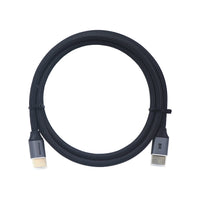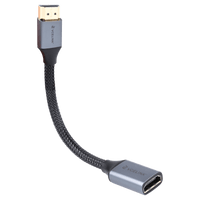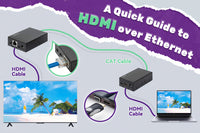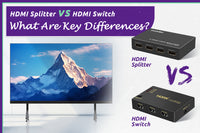Contents
HDMI cables are widely used in home entertainment and professional settings, but sometimes a standard HDMI cable may not be long enough to transmit video and audio signals. In addition, the longer the HDMI cable running length, the weaker the signal can be. Fortunately, HDMI extenders offer an effective solution to this problem. But what exactly is an HDMI extender and how does it work? Dive into our comprehensive guide to HDMI extenders to uncover more details!
What is an HDMI Extender?
In simple terms, an HDMI extender is a device used to extend the HDMI signal over a longer distance beyond the limitations of standard HDMI cables. Typically, the reliable length of HDMI cables is 15~25 feet, which can restrict the signal transmission capability and affect the signal transmission quality due to signal degradation. HDMI extenders can overcome this limitation by using various cables and transmission methods. HDMI extenders provide an effective solution to high-definition video and audio transmission between different devices like TV and Blu-ray players over long distances.
How Does HDMI Extender Work?
Every HDMI extender is equipped with a transmitter and a receiver. The transmitter is the main component of an HDMI extender. It is usually connected to the source device like computers and Blu-ray players to capture the HDMI signals. The function of the transmitter is to convert these HDMI signals into digital formats that are suitable for long-distance transmission over different cables like Cat5 or Cat6 Ethernet cables, coaxial cables, or even fiber optic cables. The signal will then be transmitted to the receiver and it decodes the received signals. The HDMI signals can be transmitted over HDMI cables for high-definition and high-quality audio and video. Furthermore, some wireless extenders can also transmit signals by the transmitter and receiver with a built-in antenna.

Benefits of HDMI Extenders?
The largest benefit of HDMI extenders is that they allow HDMI signals to be transmitted from source devices to displays over long distances. For example, in business and commercial environments, HDMI extenders enable a seamless connection between source devices to the screen that is situated far apart.
Besides, HDMI extenders also provide a stable signal transmission using technology like fiber optic and Ethernet. They can provide enhanced protection from outer interference compared to standard HDMI cables. So, they allow users to enjoy clear and undistorted audio and video.
HDMI extenders are also easy to install with their play-and-plug design, which is ideal for both professionals and DIYers. Because of the wide use of HDMI, HDMI extenders are compatible with various source devices and players. Some extenders are even equipped with advanced features for easy management and usage.
HDMI Extender Types: Wired vs. Wireless
HDMI extenders are usually divided into two types: wired and wireless extenders. Wired and wireless extenders can be divided into many types like HDMI over Ethernet, HDBaseT HDMI Extender, HDMI over Coaxial, and so on. Those different types of HDMI extenders are applied to various scenarios because of their respective features.

Wired HDMI Extenders
HDMI extenders have different cabling, including HDMI cables, network cables, coaxial cables, and fiber optic cables. Here are some typical wired HDMI extenders:
- HDMI over Ethernet: HDMI over Ethernet, also called HDMI over IP, HDMI Balun, or HDMI over LAN. It is a technology for transmitting HDMI signals over the existing IP networks. It uses Ethernet cables to extend audio and video transmission, including Cat5e and Cat6 cables. It is suitable for digital signage and conference rooms.
- HDBaseT HDMI Extender: It is also an HDMI extender that uses Cat5e or Cat6 cables but can support higher resolutions. HDBaseT HDMI extender usually features Power over Cable (PoC) capabilities and advanced functions like IR control and USB extension. HDBaseT HDMI extenders can extend the connection up to 330 feet. Compared with standard Ethernet HDMI extenders, HDBaseT extenders provide better performance. It is generally used for high-performance AV setups.
- HDMI over Coaxial: It transmits HDMI signals over traditional coaxial cables like RG6 and RG59 cables. That is to say, the HDMI over the coaxial extender is compatible with existing coaxial infrastructure. But it is not commonly used in modern life.
- HDMI over Fiber Optic: It delivers HDMI signals using fiber optic cables, which are known for their high bandwidth, interference resistance, and minimal signal loss over long distances HDMI over fiber optic extenders ensure high-quality signal transmission in large rooms and outdoor installations.
Wireless HDMI Extenders
A wireless HDMI extender transmits signals without the need for physical cables, using frequency waves for transmission and communication. The biggest benefit of wireless HDMI extenders is their easy setup and elimination of cable clutter.
In addition to its easy installation, the wireless HDMI extender also offers flexibility in device placement. You can place it anywhere between source devices and displays. However, it is more susceptible to outer interference without physical cables, which may result in signal loss and degradation. It is also a bit more expensive than a traditional HDMI extender, but the overall cost is lower.
How to Choose an HDMI Extender?
To select the right HDMI extender from various available options, you need to consider a lot of factors, such as installation distance, display resolution, and device compatibility. An HDMI extender is primarily used to address distance limitations, so you need to consider the distance between the source device and display to choose the most suitable HDMI extender. Additionally, consider the layout of the space to determine whether a wired or wireless HDMI extender is more appropriate.
Resolution is another factor that you should consider. For example, a traditional Ethernet HDMI extender is enough for 1080P resolution, whereas a 4K resolution requires a more advanced HDBaseT HDMI extender. Some HDMI extenders can offer additional features, such as ARC/eARC, LAN connectivity, Bi-directional IR, KVM Functionality, etc.
On the other hand, the requirements for HDMI extenders vary from different scenarios.
- Home Entertainment: In a home entertainment system, HD or 4K resolution is usually required, but the connection length is usually between 30~100 meters. In this case, a standard wired or wireless HDMI extender is suitable.
- Business Meeting Room: For larger spaces, such as large conference rooms, shopping malls, or exhibition halls, the HDBaseT HDMI is ideal for long-distance transmission and high-quality resolution.
- Industrial Application: In environments surrounded by electrical or electronic devices, an HDMI over fiber optic is the best choice for superior signal quality and reliability.
Final Thoughts
HDMI extenders enable higher-quality HDMI signals over long distances, providing enhanced connection and high-definition video and audio. They are widely used in various fields like home theaters, shopping malls, and conference rooms. There are different types of HDMI extenders, and you can choose the best one according to your own needs.
For more information on this topic, you can keep up on our blogs. While VCELINK offers general and basic information for our customers and other visitors to the website, it’s not professional advice.






Be the first one to comment.
Leave a comment